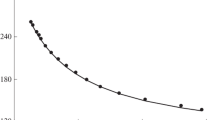Abstract
We compare the heat release data of organic glasses with that of amorphous and glass-like crystalline solids. Anomalous behavior was found in all these materials, which disagrees with the standard tunneling model. We can explain most of the experimental observations within a phenomenological model, where we assume that for a part of tunneling systems the barrier heights are strongly reduced as a consequence of the local stress produced during the cooling process.













Similar content being viewed by others
Abbreviations
- \(\alpha \) :
-
The thermal expansion coefficient
- \(\Gamma \) :
-
Grüneisen parameter
- \(\gamma _{l,t}\) :
-
\(\simeq \partial \Delta / 2 \partial u_{ik}\): Effective deformation potential for longitudinal or transversal phonons
- \(\Delta _0\) :
-
The tunneling energy
- \(\kappa _T\) :
-
Isothermal compressibility
- \(\lambda \) :
-
The Gamow parameter
- \(\rho \) :
-
Mass density
- \(\sigma \) :
-
Mechanical stress
- \(\tau _0\) :
-
Pre-exponential factor in the Arrhenius law
- \(\tau _a\) :
-
Relaxation time of tunneling systems due to phonon-assisted interaction for anomalous TLSs
- \(\tau _t\) :
-
Relaxation time of tunneling systems due to phonon-assisted interaction
- \(\tau _{ta}\) :
-
Thermally activated relaxation time of TLSs
- \(\tau ^{min}\) :
-
Minimum relaxation time of TLSs
- \(A\) :
-
A parameter proportional to \(\gamma ^2/\rho \upsilon ^5 \hbar ^4\) with dimensions J\(^{-3}\) s\(^{-1}\)
- \(C_p\) :
-
The specific heat at constant pressure
- \(D\) :
-
Deformation potential of TLSs
- \(E_0\) :
-
The zero-point energy
- \(E_{av}\) :
-
Average energy of TLSs causing the heat release
- \(m\) :
-
The mass
- \(P_0\) :
-
Constant density of states of TLSs
- \(P_a\) :
-
Constant density of states of anomalous TLSs
- \(P_C\) :
-
Constant density of states deduced from the heat capacity
- \(P_n\) :
-
Constant density of states of normal TLSs
- \(P_Q\) :
-
Constant density of states deduced from the heat release
- \(P_{a0}\) :
-
Constant density of states of anomalous TLSs deduced from the heat release long time measurement (\(t>\tau _a^{max}\))
- \(P_{ax}\) :
- \(R^*\) :
-
Cooling rate in heat release experiments
- \(T^*\) :
-
Freezing temperature; below it and for typical cooling rates the TLSs remain in a non-equilibrium state and contribute to the heat release
- \(T_0\) :
-
Measuring temperature in heat release experiments
- \(T_1\) :
-
“Charging” temperature in heat release experiments
- \(T_{co}\) :
-
Crossover temperature where the thermally activated relaxation time equals the tunneling relaxation time
- \(T^*_a\) :
-
Freezing temperature for anomalous TLSs.
- \(T^*_n\) :
-
Freezing temperature for normal TLSs.
- \(Q_1\) :
-
A fit parameter of Eq. (10)
- \(Q_a\) :
-
A fit parameter of Eq. (8)
- \(Q_l\) :
-
A fit parameter of Eq. (6)
- \(Q_n\) :
-
A fit parameter of Eq. (8)
- \(Q_s\) :
-
A fit parameter of Eq. (6)
- \(V\) :
-
Potential barrier height
- \(V_{a}\) :
-
Potential barrier height of anomalous TLSs
- \(V_m\) :
-
The average barrier height of the TLSs causing the heat release (is directly proportional to the freezing temperature)
- \(V_s\) :
-
Volume of the sample
- \(V_{ac}\) :
-
Activation volume
- \(\upsilon _{l,t}\) :
-
The sound velocity
References
S. Sahling, S. Abens, V.L. Katkov, V.A. Osipov, Phys. Rev. B 82, 174204 (2010)
H. Eyring, J. Chem. Phys. 4, 283 (1936)
R.N. Haward, R.J. Young, The Physics of Glassy Polymers. (London: Chapman and Hall, 1997)
P.W. Anderson, B.I. Halperin, C.M. Varma, Phil. Mag. 25 (1972)
W.A. Phillips, J. Low, Temp. Phys. 7, 351 (1972)
D. Tielbürger, R. Mertz, R. Ehrenfels, S. Hunklinger, Phys. Rev. B 45, 2750 (1992)
S. Sahling, S. Abens, T. Eggert, J. Low Temp. Phys. 127, 215 (2002)
D.A. Parshin, S. Sahling, Phys. Rev. B 47, 5677 (1993)
S. Abens, K. Topp, S. Sahling, R.O. Pohl, Czechoslov. J. Phys. 46, 2259 (1996)
S. Sahling, A. Sahling, B.S. Neganov, M. Koláč, Solid State Commun 59, 643 (1986)
S. Sahling, A. Sahling, M. Koláč, J. Low Temp. Phys. 73, 407 (1988)
J. Zimmermann, G. Weber, Phys. Rev. Lett. 46, 661 (1981)
J. Zimmermann, Cryogenics 24, 27 (1984)
R.B. Stephens, Phys. Rev. B 8, 2896 (1973)
A.L. Burin, Yu. Kagan, JETP 80, 761 (1995)
H. Maier, B.M. Kharlamov, D. Haarer, Phys. Rev. Lett. 76, 2085 (1996)
S. Sahling, unpublished
Nittke et al., J. Low Temp. Phys. 98, 517 (1995)
P. Esquinazi (ed.), Tunneling Systems in Amorphous and Crystalline Solids (Springer, Berlin, 1998)
M. Koláč, B.S. Neganov, A. Sahling, S. Sahling, J. Low Temp. Phys. 68, 285 (1987)
M. Schwark, F. Pobell, M. Kubota, R.M. Mueller, J. Low Temp. Phys. 58, 171 (1985)
P. Doussineau, W. Schön, J. Physique 44, 373 (1983)
K. Topp Ph. D. (Cornell University 1996)
E.I. Bunyatova, A. Sahling, S. Sahling, Solid State Commun. 75, 125 (1990)
V.G. Karpov, JETP Lett. 55, 60 (1992)
Acknowledgments
This work has been supported by the Heisenberg-Landau Program under Grant No. HLP-2013-26.
Author information
Authors and Affiliations
Corresponding author
Rights and permissions
About this article
Cite this article
Sahling, S., Koláč, M., Katkov, V.L. et al. Anomalous Tunneling Systems in Amorphous Organic Materials. J Low Temp Phys 176, 64–81 (2014). https://doi.org/10.1007/s10909-014-1162-0
Received:
Accepted:
Published:
Issue Date:
DOI: https://doi.org/10.1007/s10909-014-1162-0




